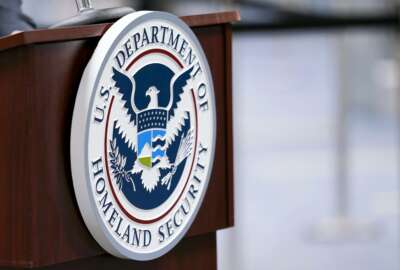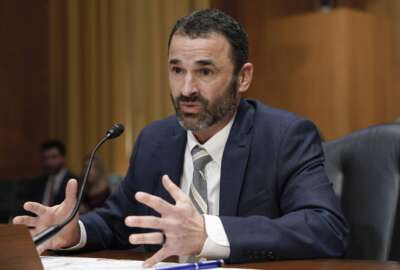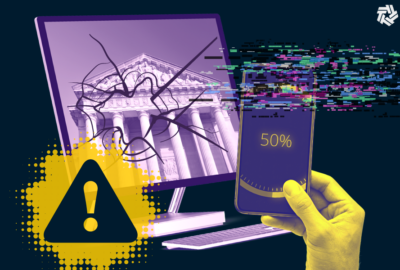Insight by DocuSign
How agencies are delivering ‘digital-first’ services to their customers
DocuSign’s Erica Fensom tells Federal News Network how agencies are making digital-first public experiences a priority.
Government websites receive more than 2 billion visits each month — a clear indication that the public demands agencies take a digital-first approach to their benefits and services.
Agencies are refining their approach to provide better service online, which is how most individuals prefer to engage with the federal government.
The Office of Management and Budget, in its recent guidance on delivering a “digital-first public experience,” said a majority of the public accesses government services online, and that a growing segment of that traffic comes from mobile devices.
Erica Fensom, vice president of corporate affairs at DocuSign, said agencies need to prioritize some of the fundamental work that makes digital-first services possible.
“The way that we’re currently receiving information and services has fundamentally changed. Whether we’re buying a cup of coffee or car insurance, we expect a fast, secure and mobile-first experience,” Fensom said. “So what if we could experience those same benefits when applying for a permit or requesting housing assistance?”
By the numbers, agencies have room for improvement when it comes to delivering a digital-first experience.
About 45% of .gov websites have not been designed to work on mobile devices. Meanwhile, only 2% of government forms are currently digitized.
“Modernizing forms is essential in any digital service strategy. In government, they’re usually the first step to someone obtaining a government service or benefit,” Fensom said. “Unfortunately, filling those forms out online can be a frustrating experience. If they’re not designed well, people abandon them.”
The White House, in a recent fact sheet on building better digital experiences, said the public spends more than 10.5 billion hours each year completing government paperwork.
About $140 billion in potential government benefits goes unclaimed each year due to complicated or outdated processes.
Some agencies have started to offer PDF versions of their forms. Fensom said this is a “right step in the digital direction,” but still far from an optimal or digital-first experience.
“If they’re not mobile-friendly, they aren’t a great user experience for the person who’s filling them out, or for the person who’s processing the information at the agency,” Fensom said.
Those PDF forms can create bottlenecks for agency employees, who often need to manually transfer the data into agency record systems.
“This slows the process and leaves room for human error,” Fensom said.
Delivering digital-first services amid pandemic
Congress directed agencies to prioritize a digital-first customer experience when it passed the 21st Century Integrated Digital Experience Act (IDEA) in December 2018.
The COVID-19 pandemic underscored the need for a digital-first approach to services, as agencies scrambled to move their operations online.
“COVID really did put a spotlight on the need for agencies to provide better digital services, and agencies moved in that direction just out of sheer necessity,” Fensom said. “The pandemic also exposed just how much room there is for improvement for agencies to provide better digital services, and how agile government agencies can be to change.”
The Department of Health and Human Services , by taking a digital-first approach, successfully administered $175 billion in grants to support families, workers, and health care providers. Congress made this additional grant funding possible through emergency COVID funds.
“They took a digital-first approach at how they were going to deliver this program and shortened the time it took to distribute grants,” Fensom said.
To build on top of progress made under 21st Century IDEA, OMB released recent guidance instructing agencies to design products and services with user experience in mind.
That includes testing digital services to meet accessibility standards and to incorporate the feedback of users through the design process.
“This is an amazing opportunity to take a digital-by-design approach in how they deliver services. And I believe there’s a huge opportunity for government agencies to create better customer experiences,” Fensom said.
To make public services digital-first, agencies are phasing out policies that require individuals to provide a physical, handwritten signature, provide paper documents or verify their identity in person.
“To the greatest extent possible, government should focus on the user experience and reduce friction in that experience,” Fensom said.
In place of those paper-based processes, agencies are implementing the 21st Century IDEA and are making the shift to electronic signatures.
“Signatures are a critical component of that moment of engagement, it’s important that experience is well thought-out, well planned, and safe and secure for your citizens,” Fensom said.
Beyond guidance and timeline for implementation from the White House, agencies are increasingly turning to the governmentwide Technology Modernization Fund to transform the way they deliver services online.
“There needs to be an ability to upgrade legacy IT systems, bring in new solutions, and also work with industry partners to help implement the best-in-class solutions to allow better customer experiences when they’re interacting with government services,” Fensom said.
First steps to deliver digital-first services
DocuSign helps more than 5,000 federal, state and local government agencies transform manual processes into automated digital experiences. But some agencies are further along in optimizing their digital services than others.
For those just getting started, Fensom said a good first step is to appoint a digital experience delivery lead.
“You need someone who’s going to take point on that digital-by-design strategy, with security in mind, to help set that vision for your agency,” Fensom said.
From there, agencies should review their top public-facing websites and “redesign with the user experience in mind.”
“Start with your forms and create web experiences, and then ensure accessibility for those experiences. As you’re doing this, it’s important to seek feedback from the public and also your industry partners. We can help guide you, in terms of the best practice for the best way to deliver those services,” Fensom said.
The latest OMB guidance also directs agencies to “meet people where they are,” and to provide important updates through the communications channels they prefer.
To meet that goal, Fensom said agencies should consider forms of communication the public most often uses. Individuals are 2.5 times more likely to read a text notification about the status of their benefit than an email.
“This is another opportunity for government to expand and think about how they’re delivering services and notifying their constituents,” Fensom said.
Copyright © 2025 Federal News Network. All rights reserved. This website is not intended for users located within the European Economic Area.
Related Stories
IRS touts better customer service through hiring surge, but GAO warns of high attrition
GSA considers text messages as new frontier for better customer experience
Featured speakers
-

Erica Fensom
Vice President of Corporate Affairs, DocuSign
-
Jory Heckman
Reporter, Federal News Network
Upcoming Events
Related Stories
Top Stories

Erica Fensom
Vice President of Corporate Affairs, DocuSign
Erica Fensom is vice president of corporate affairs at DocuSign. She leads the global team responsible for public policy, sustainability and social impact programs that support DocuSign's mission to accelerate business and simplify life for companies and people around the world.
Fensom has over 20 years of experience working with fast-growing technology companies leading corporate affairs and marketing teams across Asia Pacific, Europe and North America. She is passionate about technology and the opportunity it brings to improve the world.
Prior to joining DocuSign, Fensom led integrated marketing at Intercom, enterprise marketing campaigns at Adobe and government relations programs at BlackBerry. She also worked for the Canadian Embassy in Washington DC and the Canadian Broadcasting Corporation.
As a lifelong learner and outdoor enthusiast, she serves as a board member at the San Jose Public Library Foundation and as a volunteer scout leader. Fensom has a Bachelor of Commerce from McGill University and a Master of Business Administration from Georgetown University.
Jory Heckman
Reporter, Federal News Network
Jory Heckman has been a reporter at Federal News Network since January 2018. Jory got his start as an intern in 2011 and was a digital news writer and editor for Federal News Network from 2014 to 2018. He also worked as a desk assistant with CBS News Radio in New York and was a reporter for the Citizens’ Voice newspaper in Wilkes-Barre, Pennsylvania.





